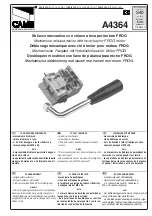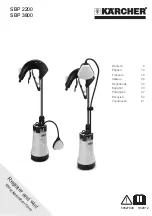
To
start
the power tool, first press the lock-off
switch
(3)
,
then
press and hold the on/off
switch
(4)
.
To
switch off
the power tool, release the on/off
switch
(4)
.
Note:
For safety reasons, the on/off switch
(4)
cannot be locked; it must remain pressed during
the entire operation.
Battery charge-control indicator
English
When the on/off switch
(4)
is pressed in halfway
or completely, the battery charge indicator
(10)
in-
dicates the battery's state of charge for several
seconds. The indicator consists of three green
LEDs.
LEDs
Capacity
3× continuous green light
≥66 %
2× continuous green light
≥33 %
1× continuous green light
<33 %
1× flashing green light
Reserve
Temperature-dependent Overload Protection
English
In the event of an overload, the speed is reduced.
Allow the power tool to cool down unloaded at its
maximum no-load speed for approx. 30 seconds.
Practical advice
English
u
Remove the battery from the power tool be-
fore carrying out work on the power tool (e.g.
maintenance, changing tool, etc.). The bat-
tery should also be removed for transport and
storage.
There is risk of injury from unintention-
ally pressing the on/off switch.
Planing Procedure
English
Set the required cutting depth and attach the
power tool with the adjustable planer base plate
(14)
to the workpiece.
u
Only bring the power tool into contact with
the workpiece when switched on.
Otherwise
there is danger of kickback if the cutting tool
jams in the workpiece.
Switch on the power tool and guide it over the
surface of the workpiece, applying uniform feed.
To achieve high-quality surfaces, apply only a low
feed rate and exert pressure on the middle of the
planer base plate.
For the processing of hard materials, such as
hardwood, and also when utilising the maximum
planing width, set only a low cutting depth and re-
duce the planer feed as appropriate.
Excessive feed reduces the quality of the surface
finish and can lead to the chip ejector quickly be-
coming blocked.
Only sharp planer blades achieve good cutting
performance and make the power tool last longer.
Chamfering edges (see figure D)
English
The V-groove
(15)
in the front of the planer base
plate enables quick and easy chamfering of work-
piece edges. Position the planer with the V-groove
onto the edge of the workpiece and guide it
along.
Groove used
Dimension a
(mm)
V-groove
2.1–5.0
Medium
0.0–2.8
Maintenance and Service
English
Maintenance and cleaning
English
u
Remove the battery from the power tool be-
fore carrying out work on the power tool (e.g.
maintenance, changing tool, etc.). The bat-
tery should also be removed for transport and
storage.
There is risk of injury from unintention-
ally pressing the on/off switch.
u
To ensure safe and efficient operation, al-
ways keep the power tool and the ventilation
slots clean.
Clean the power tool at regular intervals using
compressed air.
Keep the side cutter block guard
(8)
clear and
clean it regularly.
Transport
English
The recommended lithium-ion batteries are sub-
ject to legislation on the transport of dangerous
goods. The user can transport the batteries by
road without further requirements.
When shipping by third parties (e.g.: by air trans-
port or forwarding agency), special requirements
on packaging and labelling must be observed. For
preparation of the item being shipped, consulting
an expert for hazardous material is required.
Dispatch battery packs only when the housing is
undamaged. Tape or mask off open contacts and
pack up the battery in such a manner that it can-
not move around in the packaging. Please also
observe the possibility of more detailed national
regulations.
Disposal
English
Power tools, rechargeable batteries,
accessories and packaging should be
sorted for environmental-friendly recyc-
ling.
18 |
English
1 609 92A 72E • 2.12.21
















































